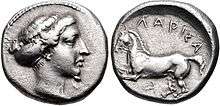Larissa (mythology)
In Greek mythology, Larissa (Greek: Λάρισσα) was a nymph from Thessaly. She was described by Pausanias as a daughter of Pelasgus. However, Hellanicus states that the sons of Poseidon and Larissa were Achaios, Phthios, and Pelasgus. Strabo (Geographika, xiv) calls her a daughter of Piasus, a Pelasgian prince.
The arx of Argos and two towns (Larissa in Thessaly and one in the Peneus) are believed to have derived their name (meaning "citadel"[1]) from her.[2]
She was represented on the obverse of common drachms produced by the city of Larissa between 400 BCE and at least 340 BCE, as a three-quarters face with outward flowing hair.[3] This style was copied from the head of Arethusa by Cimon, depicted on Syracusan tetradrachms.[3][4] According to hoard evidence from Thessaly, this coinage was produced down to c. 320 BCE.[5] Other coins depict Larissa seated, holding a hydria and with a spring nearby, confirming her status as a nymph.[6]
A moon of Neptune was discovered by Harold J. Reitsema, William B. Hubbard, Larry A. Lebofsky and David J. Tholen on May 24, 1981 and later given the name Larissa. Larissa is also designated as "Neptune VII", S/1981 N 1 and "S/1989 N 2".
References
Sources
- Bellinger, A.R. (1965). "The Thessaly hoard on 1938". INC Rome Atti. 1965: 57–60.
- Larson, Jennifer S. (2001) Greek Nymphs: Myth, Cult, Lore. Oxford, Oxford University Press. ISBN 0-19-514465-1
- Mørkholm, Otto (1991) Early Hellenistic Coinage from the Accession of Alexander to the Peace of Apamaea (336–188 BC). Cambridge, Cambridge University Press. ISBN 0-521-39504-6
- Pausanias, Description of Greece, 2.24.1. available online
- Smith, William (1849) Dictionary of Greek and Roman Biography and Mythology.
- Strabo, Geographika, xiv
External links
- LarissaTora.com A website about the prefecture of larissa with the coin image in its banner (contains some information about the mythological Nymph named Larissa also).
- Silver coin with head of Larissa
